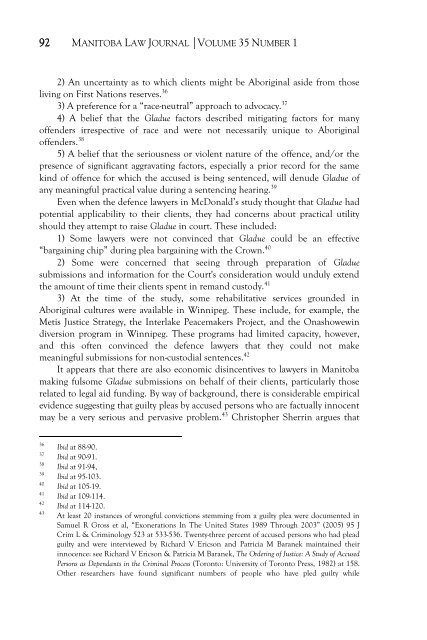Download PDF - Robson Hall Faculty of Law
Download PDF - Robson Hall Faculty of Law
Download PDF - Robson Hall Faculty of Law
You also want an ePaper? Increase the reach of your titles
YUMPU automatically turns print PDFs into web optimized ePapers that Google loves.
92 MANITOBA LAW JOURNAL |VOLUME 35 NUMBER 1<br />
2) An uncertainty as to which clients might be Aboriginal aside from those<br />
living on First Nations reserves. 36<br />
3) A preference for a “race-neutral” approach to advocacy. 37<br />
4) A belief that the Gladue factors described mitigating factors for many<br />
<strong>of</strong>fenders irrespective <strong>of</strong> race and were not necessarily unique to Aboriginal<br />
<strong>of</strong>fenders. 38<br />
5) A belief that the seriousness or violent nature <strong>of</strong> the <strong>of</strong>fence, and/or the<br />
presence <strong>of</strong> significant aggravating factors, especially a prior record for the same<br />
kind <strong>of</strong> <strong>of</strong>fence for which the accused is being sentenced, will denude Gladue <strong>of</strong><br />
any meaningful practical value during a sentencing hearing. 39<br />
Even when the defence lawyers in McDonald’s study thought that Gladue had<br />
potential applicability to their clients, they had concerns about practical utility<br />
should they attempt to raise Gladue in court. These included:<br />
1) Some lawyers were not convinced that Gladue could be an effective<br />
“bargaining chip” during plea bargaining with the Crown. 40<br />
2) Some were concerned that seeing through preparation <strong>of</strong> Gladue<br />
submissions and information for the Court's consideration would unduly extend<br />
the amount <strong>of</strong> time their clients spent in remand custody. 41<br />
3) At the time <strong>of</strong> the study, some rehabilitative services grounded in<br />
Aboriginal cultures were available in Winnipeg. These include, for example, the<br />
Metis Justice Strategy, the Interlake Peacemakers Project, and the Onashowewin<br />
diversion program in Winnipeg. These programs had limited capacity, however,<br />
and this <strong>of</strong>ten convinced the defence lawyers that they could not make<br />
meaningful submissions for non-custodial sentences. 42<br />
It appears that there are also economic disincentives to lawyers in Manitoba<br />
making fulsome Gladue submissions on behalf <strong>of</strong> their clients, particularly those<br />
related to legal aid funding. By way <strong>of</strong> background, there is considerable empirical<br />
evidence suggesting that guilty pleas by accused persons who are factually innocent<br />
may be a very serious and pervasive problem. 43 Christopher Sherrin argues that<br />
36<br />
37<br />
38<br />
39<br />
40<br />
41<br />
42<br />
43<br />
Ibid at 88-90.<br />
Ibid at 90-91.<br />
Ibid at 91-94,<br />
Ibid at 95-103.<br />
Ibid at 105-19.<br />
Ibid at 109-114.<br />
Ibid at 114-120.<br />
At least 20 instances <strong>of</strong> wrongful convictions stemming from a guilty plea were documented in<br />
Samuel R Gross et al, “Exonerations In The United States 1989 Through 2003” (2005) 95 J<br />
Crim L & Criminology 523 at 533-536. Twenty-three percent <strong>of</strong> accused persons who had plead<br />
guilty and were interviewed by Richard V Ericson and Patricia M Baranek maintained their<br />
innocence: see Richard V Ericson & Patricia M Baranek, The Ordering <strong>of</strong> Justice: A Study <strong>of</strong> Accused<br />
Persons as Dependants in the Criminal Process (Toronto: University <strong>of</strong> Toronto Press, 1982) at 158.<br />
Other researchers have found significant numbers <strong>of</strong> people who have pled guilty while














